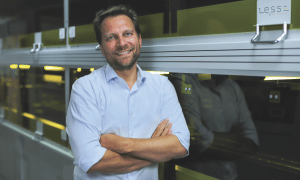Rhätische Bahn is one of Switzerland’s largest private railway operator and thanks to its CEO Renato Fasciati, it’s now the country’s most innovative.
For more than 130 years, Rhätische Bahn – Switzerland’s second largest private train operator – has transported people through the stunning Graubünden region, home to the country’s only national park. Alpine valleys descend from high mountains, rivers flow in every conceivable direction, and picturesque villages rich in Romansh culture make Graubünden truly unique. Rhätische Bahn, known as RhB, combines tradition and innovation, making it one of the most reputable train companies in the world.
Established by Dutchman Willem Jan Holsboer in 1888, the network originally only linked the Swiss cities of Landquart and Davos, but it now comprises 384 km of electrified track. RhB’s trains are used by locals and tourists alike – one of the most popular journeys is the Bernina Express railway route, a 156 km ride through the Alps. It takes four hours and rolls from Chur to St. Moritz, gliding up to glistening glaciers before descending down to the palms of Tirano. The train negotiates 55 tunnels and 196 bridges and at the highest point on the RhB, 2,253 metres above sea level, passengers will find the Ospizio Bernina. Here, visitors can delight in the cultural and natural surroundings and enjoy the Alps at their most impressive. The Thusis-Valposchiavo-Tirano railway line has UNESCO World Heritage status and the modern panoramic cars give unrestricted views of the unspoilt mountains.
RhB’s CEO is Renato Fasciati – he has a wealth of experience including past executive roles at railway companies Swiss Federal Railway, SBB Cargo AG, and ZB Zentralbahn AG. “RhB is certainly one of the most popular railway companies in Switzerland for tourists, which is no surprise given how stunning our routes are,” Renato says. “Everyone who works for the company is very proud of what we do, and I like to think the Swiss people are proud as well. Our operational excellence is known around the world, in fact, when I went to Japan, I even saw an RhB model railway in someone’s garden covering more than 1,000 m2, and the owner had never been to Switzerland. It’s crazy, people really love the combination of mountains and trains.”
Long history
From 1907 to 1910, the Rhaetian Railway, together with the federal and cantonal governments, undertook a huge expansion of its network. The Landquart-Thusis line opened in 1896 – this was followed by the Albula line in 1904 – and the series of expansion projects carried on until 1922. There are now 624 bridges and 115 tunnels across the network, the longest is the Vereina Tunnel which stretches 19,042 km. The Albula and Bernina railway lines are the heart of the RhB UNESCO World Heritage site. Both lines connect the Upper Engadine to facilitate international tourism, as well as being popular tourist attractions in their own right.
Appointed as the head of the company four years ago, Renato has worked to make RhB more “agile” and strived to “change the culture so that adopting innovation and not fearing mistakes has become commonplace.” He says that this hasn’t been easy because first and foremost, train companies need to be associated with security and safety, but since the start of his tenure RhB he has brought in several new successful products. “We are embracing change,” he adds.
Click here to read the full article.












